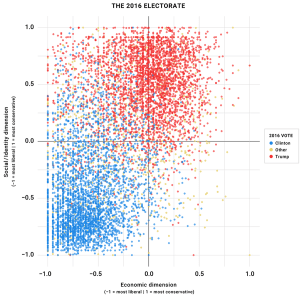The myth of asymmetric polarization

When progressives talk about the culture war, they tend to place themselves in a passive role.
It's conservatives who are the aggressors, they claim, with Republicans driving "asymmetric polarization" while being cheered on by a right-wing media complex that cynically increases its own profits by encouraging a relentless march toward outright authoritarianism. And all of it is made possible by the bigotry — racism, sexism, nativism, xenophobia, homophobia, and transphobia — of the Republican rank-and-file, for whom cruelty is the entire point. Faced with this furious onslaught of anti-democratic rage, progressives merely insist on standing their ground, defending the rights of the oppressed against their historic and present-day oppressors.
As with most self-serving political narratives, there is considerable truth to this story. On some issues, Republicans have indeed moved further right. Donald Trump really did appeal to and activate dormant (or barely concealed) prejudices among some GOP voters. His lies — especially those wrapped up with the 2020 election — have been extraordinarily damaging to American democracy, far surpassing anything we've so far seen on the left.
Yet that doesn't mean progressives have been merely defensive in the culture wars. On the contrary, as a series of charts recently compiled by center-left political commentator Kevin Drum show, progressives have been aggressors, moving left further and faster than conservatives have moved right, on numerous issues wrapped with the country's cultural conflicts over the past two decades. If this is true, or even partly so, it complicates in an illuminating way the story of a unilaterally belligerent right and virtuously defensive left.
Drum's charts cover public opinion over the past 20-25 years on a range of issues. The takeaways are striking. (I have interpreted the data somewhat differently than Drum on a few of the charts, so the conclusions I come to don't always match his.)
On immigration: Republican views have bounced around a lot since 2000, but the overall trajectory has been a shift of about five points in the more conservative (restrictionist) direction. Over that same period, Democrats have shifted about 35 points to the left, in favor of fewer restrictions.
On abortion: Since 2000, there has been a 7-8 percentage point rise in the number of Republicans holding the most extreme pro-life position (abortion should be illegal in all cases). Over the same time period, there has been a 20-point jump in the number of Democrats holding the most extreme pro-choice position (abortion should be legal in all cases). The middle position of "legal under certain conditions," meanwhile, is currently about 30 points more popular among Republicans than the extreme position. Among Democrats, the extreme and the moderate positions have been held by similar numbers for much of the past decade.
On same-sex marriage: Democrats have moved 50 points in the leftward direction since 1997, while Republicans have also moved left, though only by 39 points.
On guns: The GOP has become roughly 10 points more conservative (in favor of gun rights) over the past two decades, whereas Democrats have become about 20 points more liberal (in favor of gun restrictions).
On religion: Between 1998 and 2018, the number of Republicans describing themselves as "very" or "moderately" religious has bounced around between 65 and 75 percent. Democrats, by contrast, held mostly steady above 60 percent until around 2013, when a decline began that has left them at just under 50 percent.
All of these trends culminate in an additional chart Drum shares in a second blog post.
This one, from the Pew Research Center, shows the rise of political polarization from 1994-2017 in a series of graphs. Back in 1994, the two parties overlapped considerably, with the median Democrat and Republican quite close to each other. By 1999, both had slid left, though the median Democrat somewhat more so. Five years later, the median Republican had followed the Democrat leftward. The median Democrat didn't move much between then and 2011, but the median Republican moved significantly back to the right. Over the next three years, the parties moved away from each other, but between then and 2017, the median Democrat moved significantly to the left, with the median Republican staying mostly put.
Focusing on the median member of each party misses another dimension of the change over time. In addition to the center of each party pulling away from the other between 2011 and 2017, and the Democrats moving quite sharply left during the last three years covered by the graphs, the overlap between the parties as a whole has significantly diminished. That's the process of partisan polarization in visual form.
But the shape of each party's distribution of voters has also changed. Where both parties once looked like standard normal distributions, with the bulk of voters in the middle of their respective ideological clusters, now the Republican hump (the place on the spectrum where the greatest numbers of voters are found) falls to the right side of its distribution and the Democratic hump falls on its left side. Moreover, the Democratic hump is higher than the Republican one, showing that Democrats now have somewhat greater ideological consensus in support for the left than the Republicans do in support for the right. This difference between the parties was also picked up in a widely discussed scatterplot of the 2016 electorate produced by the Voter Study Group. It showed that Democratic voters were more ideologically clustered than Republican voters.

Voter Study Group
What does all of this amount to?
For one thing, it shows that American polarization is happening much less asymmetrically than many Democrats would like to believe — and that on certain issues wrapped up with the culture war, Democrats have moved further and faster to the left than Republicans have moved to the right. This has been obscured by a greater embrace of brinksmanship on the right, from willingness a decade ago to shut down the government and risk default on the debt to Trump's thoroughly reckless mendacity surrounding the 2020 election.
The GOP has also appeared to lurch especially far to the right because Trump flipped the party's official positions on immigration, trade, and (somewhat less so) foreign policy. But while those changes represented a genuine rightward shift of position for some, the evolution also brought the institutional party into greater alignment with the longstanding views of many Republican voters.
Why would progressives deny this reality? Aren't they committed to constantly pushing the moral envelope and furthering justice in our national life? One might think this would lead them to own these ideological shifts and speak of them with pride.
Yet doing so would require that they cede some of the moral high ground in their battles with conservatives, since it would undermine the preferred progressive narrative according to which the right is motivated entirely by bad faith and pure malice. The truth is more complicated. Conservatives genuinely believe themselves to be confronting an ever-changing, ever-expanding list of progressive demands backed up by the left's considerable cultural and political power. The right would be far less politically effective if the left did not continually provide it with evidence to verify the accusation.
This doesn't at all mean the left should surrender in the culture war in the hope that it will deprive the right of fuel for its own crusades. But it does mean that the left's actions in the culture war actually have an effect on what the right does, and vice versa. Too often progressives treat their own cultural commitments as following from self-evident and nonnegotiable moral imperatives rather than strategic political calculations.
Making progressive politics a little bit less about public displays of righteousness might help to encourage Democrats to choose their battles more wisely — and so also somewhat less inclined to pick fights with the right on immigration and abortion and guns and religious issues all at once. Maybe waging one or two culture-war battles while displaying intentional moderation on a few others would do much greater good — by giving Democrats a modest electoral boost in a sharply divided country — than taking bold moral stands on all of them and confirming the right's most paranoid claims about progressives ambitions.
But even if there is nothing directly to be gained from admitting the left's contribution to the culture war, it should still be encouraged — because that contribution is real, and because a politics firmly rooted in reality is preferable to the politics of unpersuasive denials.
You may also like
Britain is going to try to 'live with' COVID. The rest of the world is watching.
Fox is launching a weather streaming service, and it's already feuding with The Weather Channel
